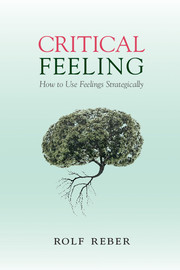Book contents
- Frontmatter
- Dedication
- Contents
- Preface
- Part I The basics of critical feeling
- Part II Applications of critical feeling
- 4 Happiness through critical feeling
- 5 The role of sensory and bodily feedback
- 6 Living together
- 7 Critical feeling in business and politics
- 8 Critical feelings at school
- 9 Music, art, and literature
- 10 Religion and morality
- Epilogue
- Notes
- References
- Index
7 - Critical feeling in business and politics
from Part II - Applications of critical feeling
Published online by Cambridge University Press: 05 March 2016
- Frontmatter
- Dedication
- Contents
- Preface
- Part I The basics of critical feeling
- Part II Applications of critical feeling
- 4 Happiness through critical feeling
- 5 The role of sensory and bodily feedback
- 6 Living together
- 7 Critical feeling in business and politics
- 8 Critical feelings at school
- 9 Music, art, and literature
- 10 Religion and morality
- Epilogue
- Notes
- References
- Index
Summary
It was Napoleon, I believe, who said that there is only one figure in rhetoric of serious importance, namely, repetition. … The thing affirmed comes by repetition to fix itself in the mind in such a way that it is accepted in the end as a demonstrated truth.
(Le Bon 1960/1895, p. 125).When I moved into my new office, there were three books from my predecessor left on my desk, two about statistics and one titled Behavior in Organizations (Greenberg and Baron 2008). When I browsed the book, I found a section on the role of emotions in organizations that was partitioned into subsections. The first two subsections were titled “Are happier people more successful on their jobs?” and “Why are happier workers more successful?” Workers’ happiness in these two sections is not seen as a value in itself but as a means to increase performance and success. Even when the authors later discuss the adverse effects of stress, they first discuss stress and task performance before they address physical health, desk rage, and burnout. The business literature too often presents issues from the viewpoint of employers or managers who have to keep their company up and running. When you browse marketing and consumer research journals it becomes obvious that many articles describe implications from the side of the marketer. Moreover, a new wave of psychologists and behavioral economists are helping governments “nudge” citizens into behaviors desired by the state authorities (Thaler and Sunstein 2008; see Burgess 2012 for a critique). There is a growing number of exceptions to the rule that marketing takes the side of industry or the state. An early example is an article by Kotler and Zaltman (1971), who examined how marketing techniques could be used for social causes. To nudge citizens to smoke less or to pay their taxes may be seen as a laudable enterprise. However, there may be examples of influencing people to show behavior desired by the state or the economy that amount to abuse rather than use. Does a scientist have the license to do research that helps a car dealer trick his customers into buying a more expensive car than they can afford? How could any responsible behavioral economist examine credit schemes that maximize consumption but increase consumer debt in unison?
- Type
- Chapter
- Information
- Critical FeelingHow to Use Feelings Strategically, pp. 163 - 179Publisher: Cambridge University PressPrint publication year: 2016

